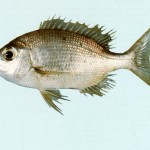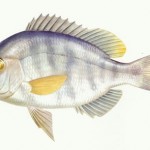Species: Gymnocranius griseus
English Name: Grey Large-eye Bream
Chinese Name: 灰裸頂鯛, 白鱲
Family: Lethrinidae
Description:
The Grey Large-eye Bream has a silverish-blue body with 10 dorsal spines, 9-10 dorsal soft rays, 3 anal spines and 9-10 anal soft rays. Can grow up to a length of 35 cm. Lives in sheltered coastal bays, sand, and mud slopes in depths over 20 m. Preys on bottom-dwelling invertebrates. Used for commercialization.


Photos used under a Creative Commons license
References:
– Carpenter, K.E. and G.R. Allen, 1989. FAO Species Catalogue. Vol. 9. Emperor fishes and large-eye breams of the world (family Lethrinidae). An annotated and illustrated catalogue of lethrinid species known to date. FAO Fish. Synop. 125(9):118 p. Rome: FAO.

